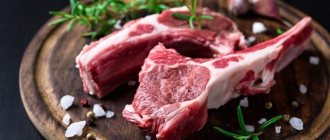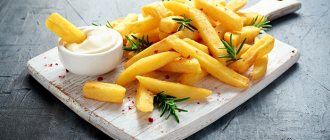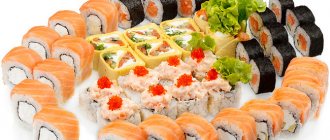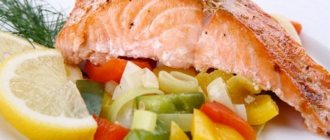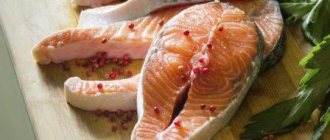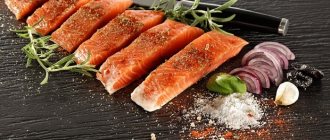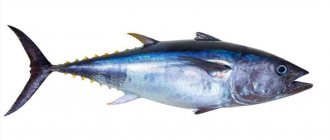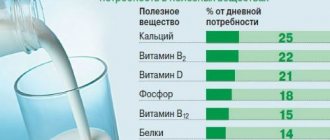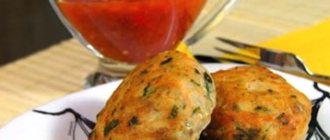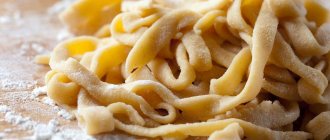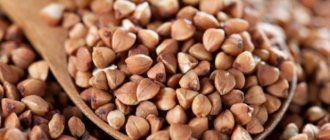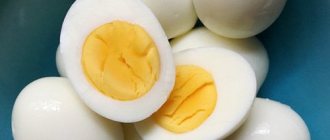Tuna belongs to the mackerel family.
The red meat has a dense structure and an interesting taste. It is worth finding out the calorie content of tuna in kcal for different processing and preparation methods, and familiarizing yourself with the dietary qualities of the seafood. Are you cooking tuna?
- Yes 89%, 626 votes
626 votes 89%626 votes - 89% of all votes
- No 10%, 68 votes
68 votes 10%
68 votes - 10% of all votes
- I don't eat fish 1%, 8 votes
8 votes 1%
8 votes - 1% of all votes
Total votes: 702
28.11.2019
- Yes 89%, 626 votes
626 votes 89%626 votes - 89% of all votes
- No 10%, 68 votes
68 votes 10%
68 votes - 10% of all votes
- I don't eat fish 1%, 8 votes
8 votes 1%
8 votes - 1% of all votes
Total votes: 702
28.11.2019
×
You or from your IP have already voted.
KBJU canned in its own juice
The calorie content of canned tuna in its own juice is 96 kcal per 100 g of product. How much protein, fat and carbohydrates does it contain:
- tuna proteins – 22.5 g;
- fats – 0.7 g;
- carbohydrates – 0 g.
Cans of tuna in its own juice are the most popular type of canned food. Fish retains beneficial qualities: vitamins, fatty acids, macroelements. Canned food is free of carbohydrates, cholesterol, and harmful fats.
@ lunamarina — depositphotos.com
Canned fish in a jar is valuable because after catching the seafood, it must be processed or frozen as quickly as possible so that histamine does not accumulate in it. The hormone in the active phase leads to allergies. If this does not happen, processing technologies are violated, then the seafood can harm the body.
Harmful qualities of canned food
Eating tuna, like any other product, has not only positive effects on the body, but also harmful effects.
The disadvantages of the product include:
- the ability to accumulate toxic substances that enter the fish’s body through blood vessels and skin. Eating contaminated meat can result in problems with memory, vestibular system, speech and hearing;
- Canned food with a high sodium content can cause just as much harm. A fish dish with too much salt has this negative feature. Food prepared with a high content of this component can lead to fluid retention in the intercellular space and increased blood pressure.
To minimize the possible negative consequences of eating fish, you need to limit the size of portions and remember that the product canned in its own juice will bring more benefits.
Harmful bisphenol A
This chemical substance, first synthesized in the last century by the Russian scientist A.P. Dianin, is an analogue of the female hormone estrogen. The entry of this substance into the human body can have dangerous consequences for his health and negatively affect his offspring.
The presence of biphenol-A in the body can lead to genetic damage to DNA, the development of cancer, and type II diabetes.
The reason for the presence of a harmful chemical compound in a valuable product was the so-called plastic pollution of the marine environment. The chemical element released from plastic accumulates in the organisms of the inhabitants of the underwater depths. There is no need to exclude fish from your diet if you consume it in limited quantities.
In oil
The calorie content of tuna in vegetable oil is 190 kcal per 100 grams. Seafood contains a lot of protein, which breaks down well. The dish contains vitamin A and many useful elements:
- calcium;
- iodine;
- zinc;
- phosphorus;
- manganese;
- sodium.
This composition can improve metabolism and prevent the formation of cancer cells.
People are interested in how much BJU is contained in the product. 100 grams of canned butter contain 27.1 g of protein, 9 g of fat, and no carbohydrates.
@ viperagp — depositphotos.com
Musculoskeletal health
Canned tuna contains everything necessary for normal growth and development of the musculoskeletal system in children.
Canned tuna contains a lot of calcium, phosphorus and magnesium, which are necessary for the formation and growth of bones and teeth.
The protein that this fish is so rich in is a “building material” for the human body and, first of all, muscle tissue. That is why eating this fish is very useful for children, adolescents, pregnant women, athletes and people who have an increased need for this substance. Fish oil, which is rich in sea fish, is also recognized as a useful product for the normal growth and development of children.
KBJU fresh
Tuna is a moderately fatty variety. The nutritional value of fresh fish is 101 kcal per 100 g. Protein contains 23 g, fat - only 1 g. Tuna meat does not have a strong pronounced taste, for this reason in France it is called fish or sea veal. This name is partly explained by the structure of the pulp - it is dense, reminiscent of meat.
In Japan, tuna is used to make sushi because its raw meat is not susceptible to parasites.
The fresh product is best cooked on the grill; when fried, it contains a lot of calories.
Benefits for the cardiovascular system
Many scientists associate the good health and longevity of residents of coastal areas in different countries with the presence of large amounts of seafood in their diet. The omega-3 complex contained in tuna meat helps prevent the development of atherosclerosis, one of the main causes of cardiovascular diseases. Many studies have shown that regular consumption of this fish helps reduce the content of triglycerides and low-density lipoproteins in the blood (they are responsible for the formation of atherosclerotic plaques on the walls of blood vessels).
Micro- and macroelements
The benefits of fish and the amount of kcal are determined by its composition, concentration of vitamins and elements. Tuna contains many substances that help the body systems function normally:
- a large amount of vitamin PP (niacin), which replenishes 77.5% of the daily requirement per 100 grams of seafood;
- vitamin B6 (pyridoxine) replenishes 40% of the norm;
- vitamin B1 thiamine is concentrated in a volume of 20% of the daily dose;
- phosphorus calculated at 35%;
- sulfur in a ratio of 19%;
- potassium – 14%;
- Among the microelements, chromium, iodine, and cobalt stand out, 100 grams of which provide 400%, 180% and 33% of the daily requirement.
@utima — depositphotos.com
The calorie content of tuna or the energy value of the product, kcal, shows the amount of energy that the body receives from the product during its digestion.
Among the microelements, chromium, selenium and cobalt stand out. The latter substance renews cells, removes cholesterol, and slows down the aging process. Cobalt helps proteins and fats to be synthesized faster. Chromium can have a positive effect on heredity by maintaining DNA integrity.
Macronutrients are as important as micronutrients. 300 g of tuna eaten covers the daily requirement of phosphorus. The substance takes part in the formation of cells. 100 g of seafood contains 190 mg of sulfur, which is equal to 19% of the norm. The substance is necessary for healthy skin, bone tissue, and improved hair condition.
Potassium strengthens the heart muscles, equalizes blood pressure, and reduces the manifestations of arrhythmias, such as tachycardia, angina pectoris, and extrasystole. The macronutrient is required for the transmission of nerve impulses to the brain. It also affects the normal functioning of the brain and memory, strengthening it. Potassium is involved in the development of the intestines, kidneys, bones and muscles.
Types of tuna and their characteristics, choosing the best type of fish
In nature, there are over 50 subspecies of this “fast” predator, reaching a length of 50 cm to 4 m and a weight of 2 to 600 kg.
The genus of schooling mackerel fish is divided into 8 species:
| Name | Description |
| Auxis Thazard (mackerel tuna) | This small (up to 40 cm long) representative of the mackerel has a silver-blue color with wavy lines on the sides, a large fin and a white belly. It spawns all year round and can be cooked in any way - frying, baking, stewing. |
| Thunnus thynnus (common or bluefin) or Bluefin tuna | The individual is bluish-black with silver stripes. Reaches a length of more than 4 m. Weighs up to 800 kg. Used for sashimi, steaks, and other dishes. |
| T.alalunga (Longfin or White) | It grows more than 1 m, weight - up to 45 kg. The back is dark blue, the belly is silver-white. Often used for canning. |
| Katsuwonus pelamis (Skipjack or Bonito) | It reaches 90 cm in length and weighs up to 23 kg. Mostly used dried or smoked, suitable for Japanese soup (dashi). |
| T. obesus (Big Eyed) | Similar to its yellowfin counterpart, but differs in its large eyes. Capable of growing up to 2 meters or more, weighing up to 200 kg. Used fried or otherwise. |
| T.maccoyii (Bluefin, Bluefin or Australian) | Occupies an average position among other tuna. It grows up to 2.5 m, weight reaches 260 kg. |
| T. atianticus (Small Atlantic) | The length of the individual is up to 120 cm, it has bright red, not very fatty meat, which is often used for preparing canned food. |
| T.aibacares (Yellowfin) | The fish is yellowish in color and has blue stripes on each side. Weighs up to 180 kg. The most popular commercial species, which produces delicious dishes - grilled, stewed with vegetables in wine. |
The choice of tuna variety depends on the dish for which the product is intended. It is always worth remembering that this is a very fatty fish, so it should be used for food in the freshest possible condition. When inspecting the carcass, you need to pay attention to the fillet - it should be dense and firm, red or dark red in color, and have a meaty aroma without any foreign impurities.
The best varieties are recognized as: Longfin tuna, Albacore, Yellowfin. No less popular is the Atlantic bonito (Bonito), which is also classified as tuna and mackerel (something in between these species).
Dietary properties
Tuna is recommended for consumption during a diet. In three days of proper nutrition, people lose 2 kg of excess weight. This is due to the low calorie content. Fish must be consumed throughout the diet. It contains a lot of protein, which improves the body's functioning. The substance forms the skeletal system and muscle tissue. But fat does not enter the body. In addition to taking tuna, you need to drink 1.5-2 liters of water per day.
Fish is eaten fresh or canned; it contains less calories.
Tuna contains Omega-3 polyunsaturated fatty acids, which provide the body with energy throughout the day. The effectiveness of seafood consumption is explained by its low fat content, only 0.8% per 100 grams of product.
@Katyjay — depositphotos.com
When eating tuna, it is important to prepare low-calorie side dishes. Potatoes, pasta and rice do not go well with seafood. It is recommended to choose broccoli, zucchini, and green beans. The ideal option is a salad of fresh tomatoes and cucumbers.
The dietary properties of seafood are unique. Meat is not only low in fat and calories, it is chock full of nutrients. Omega-3 polyunsaturated fatty acids, which fish is rich in, are involved in the production of the hormone leptin. The substance balances appetite and the amount of food consumed. The hormone controls the process of overeating and helps to achieve maximum saturation of the body.
Summarize
- Canned tuna is a nutritious and inexpensive source of protein.
- Since canned tuna lasts for several years, it is great for stocking the pantry with easy lunches and snacks.
- Choose organic varieties that are low in mercury. To do this, choose products made from light or skipjack tuna and make sure it has MSC certification on the label.
The article was prepared by experts for informational purposes only. It should not be used as a guide for treating medical conditions and is not a substitute for professional medical advice, diagnosis, or treatment. In case of illness or any symptoms, you should always consult a doctor and not self-medicate.
Tags: Tuna
About the author: Alexander Fedorov
Candidate of Biological Sciences, biologist, nutrition expert. Graduated from Stavropol State University with a degree in Biology at the Faculty of Biology and Chemistry.
- Related Posts
- How is bone marrow useful? Benefits and composition
- Tuna and salmon: which is healthier?
- Rainbow trout: benefits and harm to the body
« Previous entry
Where are fish from the mackerel family found?
A large predator, reaching three meters in length, is considered one of the fastest marine inhabitants.
It’s amazing that schools of fish are constantly on the move; they can reach speeds of up to 70 km/h and travel vast distances in search of food (molluscs, crustaceans, small fish). Tuna has chosen the waters of the Atlantic, Indian and Pacific oceans. It is not easy to catch, since the school prefers deep-sea places. Its meat is very popular in world cuisine; one of the reasons for such high demand is that the carcass is not exposed to parasites. Fish is consumed salted, fried, boiled and even raw, sprinkled with salt.
What can you cook with tuna? Step-by-step recipes
Canned tuna, the benefits of which are always taken into account in nutrition, is most often present in a variety of salads. This preference is explained by the complete absence of bones in the product and the good compatibility of the pulp with fresh, stewed or boiled vegetables. Soups, casseroles, sushi, other cold and hot dishes, pizzas and pastas are no less in demand.
Tuna and avocado salad
Grocery list:
- sunflower oil - 2 tbsp. l.;
- lemon - 1 pc.;
- fish in its own juice - 2 cans;
- tomatoes - 2 pcs.;
- eggs - 2 pcs.;
- avocado - 2 pcs.;
- red onion - 1 pc.;
- garlic cloves - 2 pcs.;
- salt, regular sugar - 5 g each;
- greens - to taste.
Preparation procedure:
- Boil the eggs, cool, remove the shells, and chop into cubes.
- Peel the avocado and onion, cut into small pieces. Arrange the tomatoes in the same form and chop the garlic.
- Combine processed foods in a serving bowl. Add tuna fillet and chopped greens.
- Sprinkle the salad with lemon juice, season with salt, sugar and butter.
Mix the mixture and serve the salad.
Tuna soup
List of components:
- sunflower oil - 30 ml;
- onion, carrot, tomato - 1 pc.;
- can of tuna;
- rice - 60 g;
- drinking water - 2 l;
- a pinch of regular sugar;
- salt, herbs - according to preference.
Cooking order:
- Remove the skins from the potatoes, rinse, and cut into small cubes.
- Place the tuber pieces in a saucepan, add filtered water, and heat the mixture to a boil. Cook the product for 10 minutes.
- Peel the carrots and onions, chop into cubes, fry in oil until soft. Add chopped tomato, pepper, salt and sugar. Simmer for 5 minutes.
- Add vegetables and well-washed rice to the container with potatoes, continue the process for another 10 minutes, then add pieces of canned fish. Finish cooking after 5 minutes.
Serve the soup to the table, sprinkle with chopped herbs.
Tuna casserole
Product set:
- sunflower oil;
- whole milk - 200 ml;
- canned tuna - 400 g;
- rice - 400 g;
- cherry tomatoes - 15 pcs.;
- Mozzarella cheese - 200 g;
- eggs - 4 pcs.;
- onion feather - 1 bunch;
- salt, pepper - to taste.
Cooking sequence:
- Boil the rice until ready in salted water, drain in a colander.
- Mash the tuna meat without broth with a fork and combine with the cereal.
- Spray the baking dish with oil and add the rice and fish mixture.
- Place small tomatoes and chopped onions on top.
- Grate the cheese, mix half the chips with eggs and milk, add salt and pepper to the mixture, and pour it over the rice layer. Leave the container for 20 minutes. into an oven heated to 180°C.
- In 10 min. Before the end of cooking, sprinkle the workpiece with the remaining cheese.
Serve the casserole hot.
Simple tuna pie
Required components:
- butter;
- yeast dough - 600 g;
- onion - 1 pc.;
- canned tuna - 300 g;
- potatoes - 5 pcs.;
- salt, pepper - to taste.
Cooking technology:
- Peel the tubers, rinse, cut into strips. Add finely chopped onion.
- Drain the tuna and mash the flesh with a fork.
- Divide the finished dough into 2 pieces.
- Roll out a large part, transfer the layer to a baking sheet dusted with flour, and form sides.
- Place the potato and onion mixture on the sheet of dough and smooth out the mixture. Place the mashed fish on top and scatter pieces of butter over it.
- Cover the food with the second crumpet, pinch the edges in the shape of a pigtail.
- Prick the top layer in several places with a fork and brush with beaten egg.
- Bake the product for 40 minutes. at a temperature of 180 °C.
Remove the pie from the oven, brush with oil and cover with a towel. Leave the baked goods in this form for a quarter of an hour.
Half is overboard
GOST 7452-97 clearly lists the organoleptic indicators that canned fish, including tuna, must meet. Here they are:
The taste is pleasant, characteristic of canned food of this type, without any foreign taste.
The smell is pleasant, characteristic of canned food of this type, without any foreign odor.
The consistency of fish meat is tender, juicy or dense. Perhaps a bit dry.
The consistency of the bones and fins is soft.
Condition of the fish – the pieces of fish are whole and do not fall apart when put out of the jar. The cross section of the pieces is smooth.
The state of the broth - with or without the presence of fat on the surface. There may be suspended particles of protein, skin and fish crumbs.
The color of fish meat is characteristic of boiled meat of this type of fish.
The color of the broth is light.
The transparency of the broth is clear.
The presence of scales has been removed. It is possible to leave scales on salmon fish.
Laying order - pieces of fish are tightly laid with a transverse cut to the bottom and lid of the jar. The height of the pieces should be equal to the internal height of the jar or 4–5 mm below it.
The presence of foreign impurities is not allowed
As it turned out during laboratory tests, three out of six test participants did not meet the requirements of the standard.
Fish House tuna tasted sour to experts. Samples of "John West" and "Skipjack" (trademark "Fish Gallery") did not stand up to criticism for taste, smell and consistency. They have a taste and smell that is unusual for this type of canned food, as well as a crumbly consistency and cloudy color of the broth.
